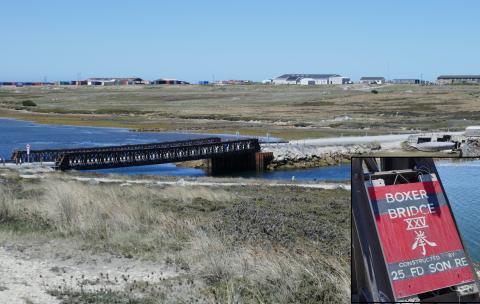In December 2022, I posted a photo of a bridge I saw at Stanley, Falkland Islands.
The bridge was built by the 25 Field Squadron, Royal Engineers in 1983. They use a Chinese character related to the boxer rebellion in 1900-1901, the translation of the character is "fist". This relates to the name of the Chinese group involved in this rebellion which is "The Society of the Righteous and Harmonious Fists".
I asked for any information how the squadron adopted the character. Tideswell27 advised me to contact the Royal Engineers museum in Chatham, Kent, which I did.
The answer was slightly disappointing as there was nothing in their records, likely as the adoption of symbols was not an official army issue. But they sent me a copy of one page of a letter from 1969 which highlights the involvement of 25 Field Squadron in the boxer rebellion as they were posted to Hong Kong in 1891. Here is the transcription of this page:
The posting to Hong Kong in 1891 was a memorable one. The Company was employed on building defences in the New Territories, acquired in 1889 [likely transposed digits, 1898 would be correct]. A great technological advance in the technique of coast defence was also made at that time by the use of the internal combustion engine, in place of the steam engine, as the prime mover or the generation of electricity.
As a result much more powerful Defence Electric Lights were possible capable of illuminating targets at a considerable range. The lights relying on steam engine generation could only illuminate a very limited area covered by short-range quick firing guns. Electrically operated captive mines and cable controlled Brennan torpedoes gave protection at greater range. Now the more powerful DELs could be used to illuminate targets which heavy coast defence guns could take on at long distances by night. The Sappers were called upon to install new searchlight positions, their directing stations and their engine rooms and to man the DELs. They were also called upon to build the batteries for the heavy guns with their engine rooms, which the lights would serve. Thus grew up the close and friendly relationship between the Garrison Gunners (RGA) and the Fortress Engineers. The development of the searchlight/heavy gun combination sounded the death knell of submarine mining as a means of coast defence, and in 1906 the Royal Navy took over from the Royal Engineers all responsibility for submarine mining and torpedoes
The Boxer Rebellion of 1900-01 provided the Company (and the 42nd (Fortress) Company from Wei-hai-wei) with a chance to demonstrate that a highly technical unit could cover itself with glory when used in a combat engineer role. The British Army at that time was still pretty stretched in South Africa, and the only troops the British Government could send to help the legations besieged in Pekin were those from Hong Kong and Wei-hai-wei and units of the Indian Army that had not been engaged in the Boer War. The exploits of the 25th and the 42nd (Fortress) Companies are set out in Volume IV of the History of the Corps of Royal Engineers and in "Engineer operations of the British Contingent China Field Force 1900-1901". I can send you then two books on loan from the Library if you require them. They make sterling reading.
During the 1914-18 War regular Fortress Companies were withdrawn from overseas garrisons and used (mostly) as Lines of Communication Troops in active theatres. The 25th (Fortress) Company was no exception. It was so employed on the Western Front until its disbandment in 1919 - having been redesignated as an Army Troops Company in August 1915. We have the War Diary of the unit for this period which I can lend you to look through. It is not terribly interesting reading, but a good discipline for a military historian.
After a long period of suspended animation the Company was resuscitated in 1948(?) [last figure not clearly readable] as 25 Field Squadron in 24 Field Engineer Regiment. It returned to Hong Kong in 1949 where once again it lost its identity on being redesignated 54 Field Squadron the following year.
So the original question was not answered, but interesting details of the Royal Engineers' work in the New Territories were reported.

Re: New Territories
Perhaps a typo provided in the lease date of the New Territories.
Re: Date
Thank you moddsey for spotting the incorrect date. The year 1889 is written in the letter. Likely transposed digits.
25 company royal engineers
Hello folks, I have posted before about looking for info on my great grandfather (I was looking for the hospital where his son was born.) I wonder if his military role in HK could be relevant to the post above.
On the birth cert it says 'command 25 company royal engineers' in Hong Kong, that is the description of the person registering the birth I believe whereas the father of the baby was 23 Co I think - I can't find it at the moment! I have an audio from my great uncle which talks a little about his life as a child in HK but there is also a mention of the Boxer Rebellion, nothing substantial.
I know that my great grandfather - Joseph Edward Artingstoll was in HK 1901-1904 inc. I had thought that he was a warrant officer although he had been demoted just before the posting to HK, his records show Staff Sergeant.
hope this is of interest.
Where can I get a copy of…
Where can I get a copy of the referenced book "Engineer operations of the British Contingent China Field Force 1900-1901"?
My grandfather served with 25th Fortress Company in China and Wei Hei Wei and I'm trying to find out more about their activities.
Regards,
Greg